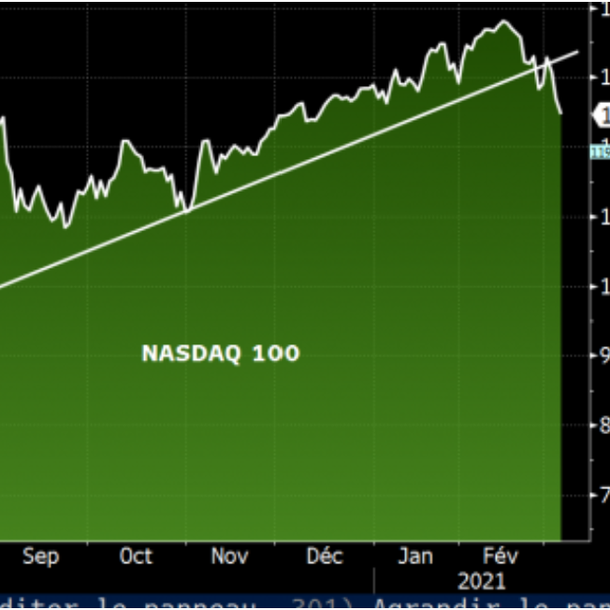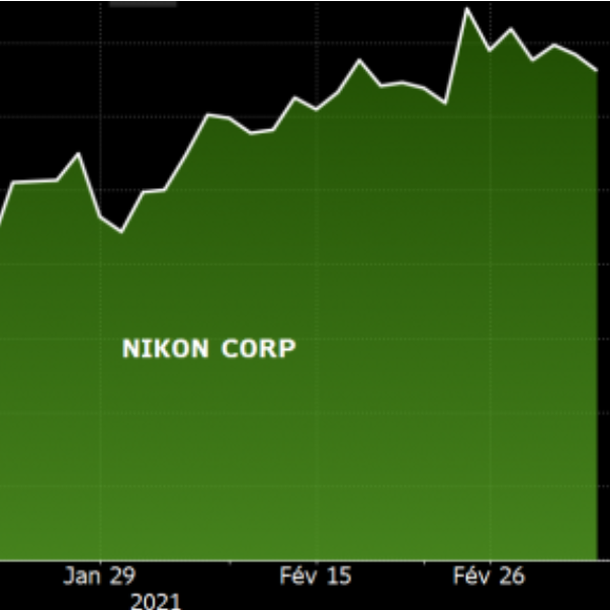|
Monday March 8 | Weekly market update |
 |
Against the backdrop of an improving economic outlook and inflationary fears, sector rotation continued last week across markets, with traders continuing to shift away from technology stocks in favor of more cyclical assets. Nervous about the renewed appreciation of bond markets, financial markets nevertheless remain on an upward trend, with risk appetite arising at the slightest consolidation. |
| Indexes Over the past week, major indices have evolved in scattered order. In Asia, the Hang Seng grabbed 0.3% while the Nikkei eroded symmetrically by 0.3% and the Shanghai Composite by 0.2%. In Europe, the CAC40 gained 1.6% with the stocks linked to raw materials and financials. The DAX rose by 1.2% and the Footsie by 2.6%. For the peripheral countries of the euro zone, Spain gained 1.2%, Italy 0.7% and Portugal fell by 0.3%. In the United States, the rise in the TBond weighed on the technology segment, like the Nasdaq100, which declined by 4.6% over the last five days. The S&P500 is down 1.5% while the Dow Jones is stable. Nasdaq100  |
| Commodities OPEC+ created a surprise last week as the enlarged Organization decided not to increase its production. The cartel wants to be cautious on the evolution of demand. The icing on the cake, Saudi Arabia unilaterally continues its efforts and extends its cuts of one million barrels per day by one month. As a result, crude oil prices have risen sharply to new annual highs. Brent is approaching the USD 70 bar while WTI is trading around USD 65 per barrel. Rising bond yields and rising gold do not go hand in hand. Real interest rates on U.S. Treasury bills continue to rise, which weighs on gold. The barbaric relic thus ends the week at a low of USD 1700. It is no better on the silver side, which is also losing ground at USD 25.2. The time has now come for consolidation in the industrial metals segment, a more than legitimate pause after the rally achieved by the entire compartment. Copper returned to USD 8730, nickel fell sharply to USD 16100, while aluminum trades at USD 2160 per ton. |
| Equities markets Let's head to Japan this week with Nikon Corporation, whose market capitalization is 3.2 billion dollars and is experiencing a bull rally. Indeed, the stock has literally taken off as it has gained more than 43% since the beginning of the year. A major name in photographic and optical equipment, the group designs, manufactures and markets its products itself. Geographically, its revenues are mainly generated in the United States (34% of its turnover in 2020), China (24.3%), Japan (16.7%) and Europe (13%). Its sales in the rest of the world generate 16.9% of its turnover. In addition to the geographical diversity of its revenue sources, the company is also diversified in terms of business sectors, with precision optics (lithography in particular) accounting for 40.6% of its revenue, "video equipment" for 38.2%, industrial equipment for 10.7% and healthcare products (optics and medical imaging) for 10.5%. Despite a difficult economic climate and a 24.9% decline in sales in 2020, the group has managed to maintain a significant cash position of nearly $1.9 billion, which suggests good investment capacity and a certain resilience in periods of turbulence. Ascending trajectory of the Nikon share  |
| Bond market The American ten-year return is making headlines and is once again approaching the symbolic 1.60% line. This upward recovery in yields is also confirmed in Europe with a French OAT at -0.08% and a German Bund at -0.25%. Still on the continental level, the ECB has just announced that it would not tolerate that rates rise too quickly and jeopardize the institute's strategy. It could, therefore, increase bond buybacks in order to lower rates. The steepening of the yield curve therefore seems to be undesirable. Despite everything, these institutional verbal interventions have little effect this weekend on the behavior of sovereign bond benchmarks. Italy and Spain, for their part, are also seeing the cost of their debt rise to 0.70% and 0.33% respectively. In Asia, the administration of rates is being perpetuated in Japan with the warning of the BOJ, ready to intervene to defend its yield objective, should these rates increase. Specialists believe that it could intervene if the yield of the 10-year government bond approaches 0.20%. Recent 10-year push  |
| Forex market After several weeks of volatility, the currency market has regained some calm. The traditional safe havens have been abandoned by traders, once again favouring more cyclical currencies. As a result, the Swiss franc and the yen continue to slide against their major counterparts. The EUR/CHF is trading at a two-year high of CHF 1.11 and the EUR/JPY parity is doubling at JPY 129. On the other hand, across the Atlantic, the dollar remains well oriented thanks in part to the tension on long rates. The greenback is also being helped by good economic figures and improved prospects for the U.S. economy. The greenback recovered both against the single currency, falling well below USD 1.20 and against the yen to JPY 107. Against the pound sterling, the cable rebounded to GBP 0.72 (+200 basis points higher than the recent low). On the southern hemisphere side, the Australian dollar remains bullish, an upward trajectory that finds a relay with the publication of a historic trade surplus over January. The kiwi is traded on a basis of USD 0.789. |
| Economic data Whether the official figures or Caixin, the manufacturing and services PMI indices have highlighted a slowdown in the growth of Chinese activity. They are respectively 50.6 and 51.4 (50.9 and 51.5 for the Caixin indices). In the euro zone, these same indices exceeded expectations at 57.9 and 45.7. The unemployment rate fell to 8.1%, the consumer price index rose by 0.9% and the producer price index by 1.4%. In contrast, retail sales fell 5.9% in January (-4.5% in Germany). In the United States, the ISM Manufacturing index (60.8) exceeded expectations, but the ISM Services index fell to 55.3 (58.7 last month). Construction spending rose by 1.7% and industrial orders by 2.6%. Regarding employment, while the ADP disappointed (only 117K private sector jobs created), the monthly report showed an unemployment rate of 6.2%, with 379K jobs created (49K last month) and hourly wages up 0.2%. |
| Concerns over rates The epidemic seems to be receding and economies are recovering, with a spectacular increase in profits prospects for this year. After a recession, characterized as the most violent in the post-war period, but also the fastest, hopes for recovery are rekindling inflationary fears. The bond market is tightening, thus initiating a turnaround. The question for investors is therefore whether central banks will be able to withstand these headwinds and continue to manage interest rates for a long time to come, an environment that is conducive to massive government indebtedness. |

 By
By 

















